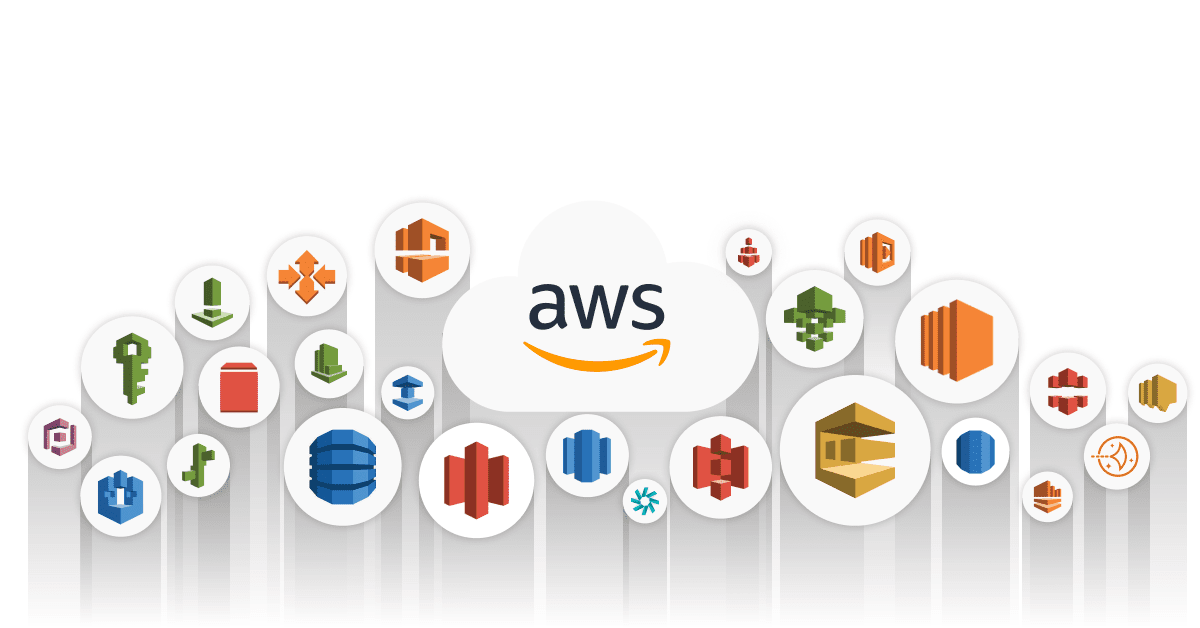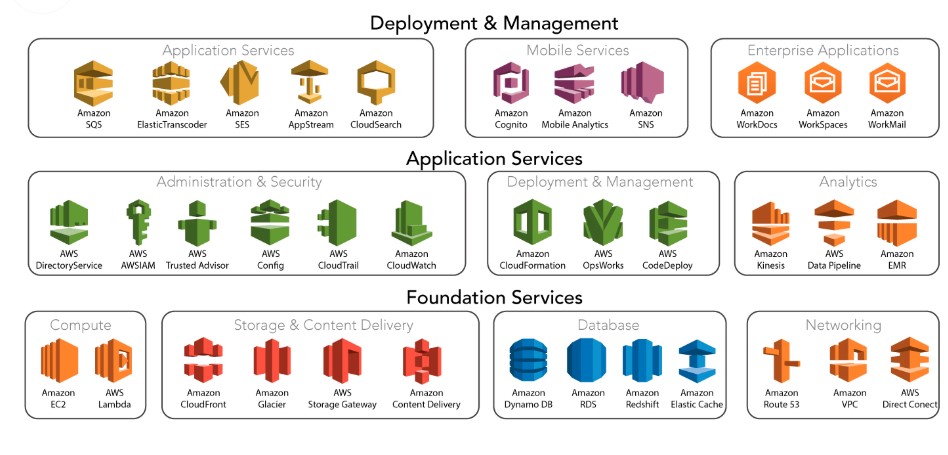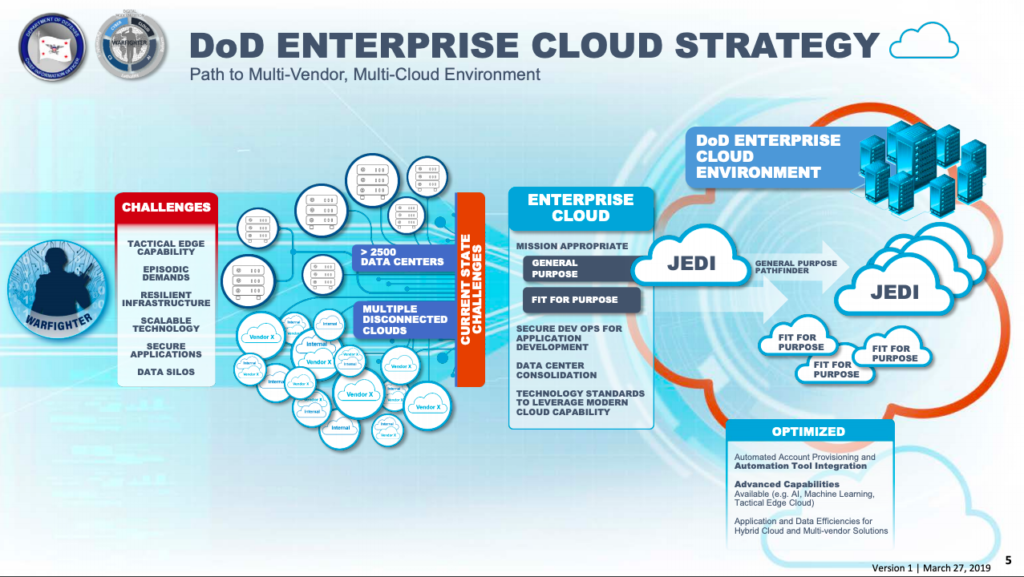Amazon Web Services (AWS)

What is AWS?
Amazon Web Services (AWS) is Amazon’s cloud division that’s focused on building the world’s most comprehensive and broadly adopted cloud platform. Prior to services like AWS, startups and tech companies had to construct their own server infrastructure. This often meant purchasing server mainframes and deploying them across the country or internationally to increase coverage and decrease latency. Amazon, created a service out of this though, so tech companies could instead focus on building their actual technology and software itself. This was a breakthrough movement in the tech industry, known as the cloud revolution. It allowed developers and startups to rapidly build and scale their businesses without incurring massive costs that we previously saw. Before we knew it, AWS had created a dominant tech and software infrastructure system that is the mainstream service adopted by most companies.
Currently, AWS offers over 200 fully featured services from data centers globally. Millions of customers—including the fastest-growing startups, largest enterprises, and leading government agencies—are using AWS to lower costs, become more agile, and innovate faster. Services include EC2, a general compute module, S3, a general blob store, DynamoDB, a key-value store, CloudFront, a content delivery network (CDN), and more. If there’s a cloud architecture and system that you need, odds are AWS has their own version that’s just as good if not better than competitors and often cheaper too.

Any developer will have heard of, if not have used AWS previously. Mentioned above, the fastest-growing startups and largest enterprises all use AWS, but to give a few examples, there are the following. Pretty much every startup that exists today, ranging from pre-seed to public scales has touched AWS before. Just to list a few, we have Airbnb, Adobe, Coinbase, Capital One, ESPN, J&J, Lyft, Slack, Spotify, Siemens, Twitch, Zillow, Yelp, etc. And funnily enough, even if the company doesn’t use AWS directly, a service or vendor they use likely uses AWS itself. AWS is the literal foundation of the world today, and we certainly wouldn’t have the depth and scale of technology that we see today without it.
The Origins of AWS

The idea behind AWS starts in the 2000, as a solid internal system for Amazon to help deal with the exponential growing the e-commerce company was having. Indeed, the company desired to start a service to help provide third-party merchants build online shopping sites. However, this process resulted to be a lot harder that they had planned due to internal organizational issues of the system since its creation in 1994. This lead to Amazon creating AWS as a way to convert their system into a set of well documented APIs, which later paved the way for a better internal development of tools.
At that time the company was including many new hires in their software engineering team, but was still failing to build applications faster. In order to tackle this issue, a set of common infrastructures services where provided for the teams at Amazon to use instead of having to start everything from scratch every time.
In 2003, this set of services where starting to be seen more as an operating system of sorts for the internet and they realized they could pursue this broader and more ambitious idea, of letting any organization run their technology applications on top of their platform, which is AWS today. Indeed, in just a few years Amazon launched this as the first ever cloud infrastructure service, and it took many years for other companies to be able to compete with it.
People Behind AWS
The actual beginnings of AWS came far before its launch in 2006. Around the year 2000, Andy Jassy, former CEO of AWS and now CEO of Amazon as a whole, began to realize that there was an issue in the way that teams at Amazon were dealing with storage and retrieval of information from databases. Then, it was not until an executive retreat in 2003 when the initial ideas which became AWS began to be articulated. At this time, there was not a formal plan for the behemoth that is now AWS, it was just a series of ideas that eventually led to its development and launch.
As a Senior Vice President, Jassy was the individual who ran the AWS team, which at its conception was a mere 57 people. In 2016, he was finally promoted to CEO of AWS, by that point a thriving cloud computing platform dominating the market space without any real competitors in range.
Now, as Jeff Bezos has stepped away from the Amazon CEO position, Jassy will move from AWS CEO to Amazon CEO, and his place at the top of the AWS ladder will be taken by Adam Selipsky, who has worked with Jassy on AWS from 2005 to 2016. At that point, he left Amazon to go to Tableau Software, where he lead the company to a quadrupling in evaluation in the span of three years. The rest of the AWS executive group is rounded out by 8 males and 1 female, of which only two of the males are not white.
What’s in Store for AWS?
Amazon with the creation of cloud computing with AWS has forever changed the IT world and today everything is moving towards the cloud. Indeed, most companies of every size are leaning towards using cloud computing and AWS is set to become the biggest corporation ever as it is in favorable position to have most of the market.
Moreover, there is no sign of its exponential growth to stop anytime soon and experts say AWS is soon to surpass Amazon’s own online retail and e-commerce business. In fact, even though its competitors are also set to keep progressing in the next years, AWS is believe to be remaining a leader in the field for the foreseeable future. This perfectly aligns with founder Jeff Bezos idea of a company that is ever evolving and is willing to take risk and keep growing.

Competitors
Having been the pioneers of the cloud computing industry, it makes a certain amount of sense that AWS remains the largest cloud computing platform in terms of market share. AWS currently controls approximately one-third of the cloud computing marker, and has been at that mark for the last couple of years. This is not to say, however, that AWS is not growing, because the overall market is increasing at a stunning pace, with annual growth of almost 30% in the US and Europe, and over 50% annual growth in China.

Despite AWS’s long tenure at the top, there are a few cloud computing platforms which pose a real threat to Amazon’s market share. These products all come from other technological giants similar to Amazon. Currently AWS’s largest rival is Azure, from Microsoft. As of earlier this year, Azure was estimated to control about 20% of the worldwide cloud computing platform, and is growing at a much faster pace than AWS. This is thanks to a larger array of products which are factored into its reported revenues, but also comparable or lower costs than AWS for their similar products. Despite having a similar revenue to Google Cloud Platform (GCP) in 2017, Azure has rapidly outpaced GCP to solidify its spot in second place.
GCP does take the third spot in the current cloud computing market share, however, at around 7%. Although it is lagging behind its two peers, it is still growing rapidly in this space and offers a wide variety of cloud computing services to its customers, which give it an edge on AWS and Azure.
Finally, a cloud computing platform which is not very prevalent in the United States or in Europe, but has a strong foothold in the rapidly growing Chinese cloud computing market, is Alibaba Cloud. The retail giant, just like Amazon did in the United States, is attempting to increase its presence in many different sectors, and currently controls around 40% of the Chinese cloud computing market. It may not yet have the global market share to concern the likes of AWS, Azure, and GCP, but if the Chinese market continues to outstrip the American and European markets in terms of annual growth, it could quickly become a very powerful platform.
There are many other cloud computing platforms which compete with these companies, notably IBM Cloud, but their none of their market shares or technological capabilities are competitive at the top.
Government Contract

Amazon Web Services decided to fight a legal battle against the Department of Defense for giving a $10 billion cloud service contract to Microsoft Azure. The case was on the premise that the president at the time, Donald Trump, had a bias against Jeff Bezos that affected the cloud decision. The DoD found legitimate reasons for Amazon’s case for the Joint Enterprise Defense Infrastructure (JEDI) contract and was forced to re-evaluate their decision resulting in the contract eventually being cancelled.
On November 19, 2021, the government announced the JEDI contract’s successor, the Joint Warfighting Cloud Capability (JWCC) contract. The major difference between the two contracts is that the JEDI contract was a one-company contract where only one company would oversee managing the Pentagon’s cloud, compared to the JWCC contract which allows for multiple companies. The DoD is giving Amazon, Microsoft, Google, and Oracle the chance to bid for the contract, excluding IBM, and has not yet announced their decision. It is expected that the contract will go to both Amazon and Microsoft.